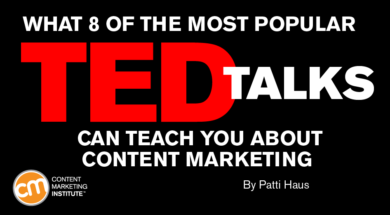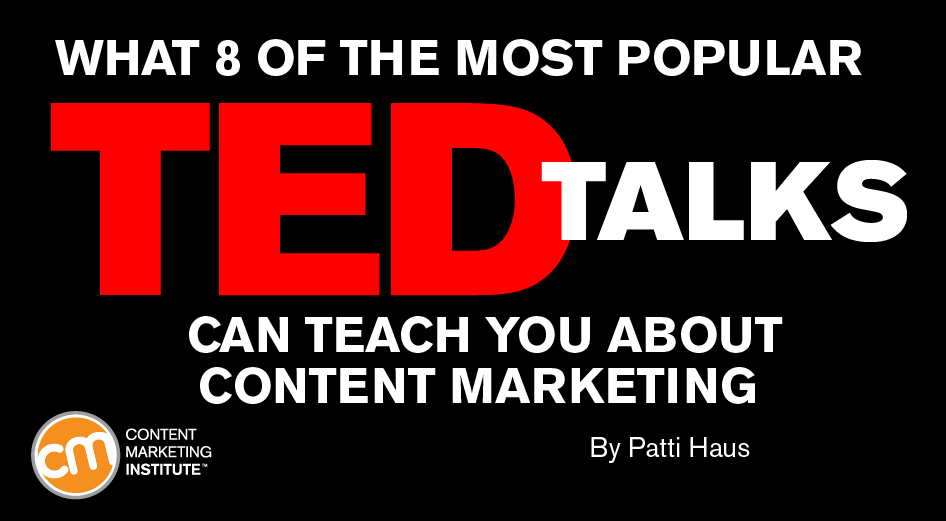 TED Talks lift powerful voices in the world of technology, entertainment, and design. And with more than 2 billion views on YouTube, what began as a simple conference has become an industry.
TED Talks lift powerful voices in the world of technology, entertainment, and design. And with more than 2 billion views on YouTube, what began as a simple conference has become an industry.
The 18-minute wide-ranging talks are the best place to learn things you never knew you wanted to learn. But what do TED Talks have to do with content marketing?
Great TED Talks – the ones that millions watch – can teach a lot about how to effectively do and use content marketing. Here are eight lessons.
Great @TEDTalks can teach a lot about how to do #contentmarketing well, says @Patti_Haus via @cmicontent. Click To Tweet1. Create for what matters to your audience
Amy Webb’s How I Hacked Online Dating shares her testing hypotheses and how she experienced an ego-busting lack of results that eventually led her to her husband.
Amy developed in-depth knowledge of her target audience (single Jewish men who enjoyed traveling and weren’t golf obsessed) to craft the ideal profile:
I was able to create a super profile, so it was still me, but it was me optimized now for this ecosystem. And as it turns out, I did a really good job. I was the most popular person online.
She used the data points about her target audience to create the exact type of content to convert her target audience.
It’s the same for content marketers seeking higher conversions.
Simply put, if you really know what matters to your prospects, you can create content that resonates with them.
Some organizations get it wrong. They stop after collecting demographic data. They know little about the audience’s pain points, emotions, and other psychographics.
Successful organizations develop in-depth audience knowledge also known as the voice of the customer. They combine quantitative and qualitative methods, and interview a sample of their audiences. They use that knowledge to write content that transcends feature-rich copy and uses emotion to connect and relate to the audience. As Jen Havice writes:
When you understand the motivations driving your prospects & customers, you can reflect their feelings back to them, says @jenhavice via @Patti_Haus. Click To TweetWhen you understand the motivations driving your prospects and customers, you can reflect their feelings back to them (in their own words, I might add).
HANDPICKED RELATED CONTENT:
2. Solve a problem
Greta Thunberg uses our desire to make the world a better place for our children as a motivator in her TED Talk, School Strike for Climate – Save the World by Changing the Rules. As she says:
The one thing we need more than hope is action. Once we start to act, hope is everywhere. So instead of looking for hope, look for action. Then, and only then, hope will come.
At the core of Greta’s message is selling the audience (rich, first-world countries) the idea that we can (and should) lead the way in reducing carbon emissions and waste.
Greta isn’t selling us to buy her mantra for ourselves. She’s persuading us to do it for our children and grandchildren – those who will be more affected by climate change and those who we love dearly.
That’s what great content does. It solves a problem that led your prospects to your content – a problem they need to solve, an opportunity to expand their knowledge, an avenue for entertainment, etc.
Use your audience’s needs, desires, or fears to create content that connects with them in a relevant and emotional way to show them you’re able to give them what they want.
HANDPICKED RELATED CONTENT:
3. Open with a great hook
Keith Barry opens his TED Talk Brain Magic by claiming he’s going to show how easy it is to manipulate the mind with the power of words, linguistic deception, and non-verbal communication to create the illusion of a sixth sense.
He follows with video. The audience watches the screen as a blindfolded Keith drives. Around curvy roads, and up and down hills, Keith and his passenger arrive safely at their destination.
Why did the video transfix the viewers? Because Keith had a great hook.
The audience couldn’t wait to see what happened next, wondering how the road trip would end.
Great content has a compelling hook. It’s necessary to keep readers glued to your content so they ultimately convert.
.@KeithpBarry drives blindly in video in his @TEDTalk. Do you have a hook to keep your audience watching? @cmicontent Click To TweetOne of the best ways to craft a great hook is using a tested formula like problem, agitation, solution. This powerful format captures your audience members’ attention with a synopsis of their struggle (the problem that led them to you). You elaborate on the impact of that problem to keep them reading. Then you offer a solution. This type of content often works well because consumers usually are more interested in avoiding or resolving pain than they are in embracing pleasure.
4. Tell a story
Powerhouse TED speaker Brené Brown uses storytelling as a main component of her talks. She sprinkles personal and business stories liberally through her talks on vulnerability, shame, and courage.
Telling stories works well, as Joe Lazauskas explains:
Stories make us remember and make us care. #Contentmarketing works because our brains are programmed for stories, says @JoeLazauskas via @cmicontent. Click To TweetEssentially our brains run on electrical pulses, and when we hear stories our brains light up. Neuroscientists have this saying that neurons that fire together, wire together. So, when we’re hearing a story and our brain is lighting up, you have all of these neurons that are then wiring together, which triggers us to remember more of the information we’re getting.”
To use storytelling in your content, remember it’s not your brand’s story you are telling. Your audience is the protagonist – the hero is struggling with a problem that your content can help them solve. Tell your customer’s story.
5. Follow the rule of one
TED curator Chris Anderson says the famous TED Talk format maxes out at 18 minutes because that’s “long enough to be serious and short enough to hold people’s attention.” It also forces speakers to focus on one idea.
Take Your Body Language May Shape Who You Are. Amy Cuddy knows that most people don’t sit around wondering if their body language affects their careers or lives. She also knows 18 minutes isn’t enough to convince listeners to make large changes to their body language.
Enter the power pose.
Amy’s one big idea is how to change your perception with a two-minute power pose. “Tiny tweaks can lead to big changes,” she says.
Research into the psychology of choice supports the singular focus. When you give your audience members many choices or options in your content, they are less likely to pick any of them.
When you give your audience many options in your #content, they are less likely to pick any of them, says @LirazMargalit via @PsychToday. Click To TweetWhile your content might not have time or length limits, remember the Rule of One. For the most effective copy, focus on one big idea designed with one customer in mind that makes one promise, tells one story, and has one call to action.
6. Know your big idea
Sir Ken Robinson shares his big idea in his TED Talk, Do Schools Kill Creativity: “Our task, as parents and educators, is to educate children’s whole being not just the STEM skills.”
Ken says our society, including educators, values math and science, rarely putting value in the arts. And that, he says, leads to less fulfilling lives:
By the time they get to be adults, most kids have … become frightened of being wrong. And we run our companies like this. We stigmatize mistakes … And the result is that we are educating people out of their creative capacities.
The idea of a big idea is as important in content marketing as it is in a TED Talk.
David Ogilvy, a marketing legend, coined the term “big idea.” Ogilvy on Advertising: “Unless your advertising contains a big idea, it will pass like a ship in the night.”
As he writes, your big idea comes from careful research. Identifying what your audience wants or needs to know. Then evaluate what ideas your competitors offer in their content. And find a big idea that is needed but not yet created.
HANDPICKED RELATED CONTENT:
7. Invite readers to act
Each TED Talk ends with a call to action. In What Makes a Good Life? Lessons from the Longest Study on Happiness, Robert Waldinger leads his call to action by first concisely expressing his big, research-based idea:
Over and over, over these 75 years, our study has shown that the people who fared the best were the people who leaned into relationships, with family, with friends, with community.
He then concludes with his call to action – lean into your relationships:
It might be something as simple as replacing screen time with people time or livening up a stale relationship by doing something new together, long walks or date nights, or reaching out to that family member who you haven’t spoken to in years, because those all-too-common family feuds take a terrible toll on the people who hold the grudges.
Similarly, each piece of content needs a call to action to let your readers know what to do next to achieve what you told them is possible. Don’t make it an afterthought – make it prominent and convincing.
Each piece of #content needs a CTA to let readers know what to do next. Don’t make it an afterthought – make it prominent and convincing, says @Patti_Haus via @cmicontent. Click To TweetHANDPICKED RELATED CONTENT:
8. Use social proof
Simon Sinek’s TED Talk, How Great Leaders Inspire Action, is thought provoking. In his invitation to the audience to change how they perceive and act on marketing, he references Apple, Martin Luther King Jr., and the Wright brothers.
Simon’s theory would be less believable without his inclusion of social proof:
As it turns out, there’s a pattern. As it turns out, all the great inspiring leaders and organizations in the world, whether it’s Apple or Martin Luther King or the Wright brothers, they all think, act, and communicate the exact same way. And it’s the complete opposite to everyone else.
Social proof, a term coined by Robert Cialdini in his book Influence maintains that a person who does not know how to act in a situation will look to others to imitate and seek guidance.
In your content marketing, think about how to communicate to your unsure audience that they are not alone, that the solution detailed will work, and that they will minimize mistakes by using it. You can tell stories in which your audience will see themselves. You can interview people respected in your industry, etc.
Cue the applause
I watched these TED Talks multiple times while I wrote this article to find the right quotes and details. As I watched them for the 12th time, I realized every one of these TED Talks is essentially content marketing.
TED Talks – the ones that grab your attention in the first minute and keep you captivated for the next 17 or so minutes – sell you on something. It’s not a physical product. It’s the speakers’ latest research or their personal story of triumph with the goal of convincing the audience to come to agree with or at least appreciate their point of view.
Get content marketing tech talks at ContentTECH Summit 2020. Join us this April in San Diego. Register today.
Cover image by Joseph Kalinowski/Content Marketing Institute

